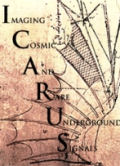INR RAS - international collaborations
European Organization for Nuclear Research - CERN

The Compact Muon Solenoid (CMS) detector at the Large Hadron Collider (LHC) is the one of four large experimental facilities. LHC program will address the fundamental questions in high energy particle physics, namely that of the Higgs boson properties, origin of the spontaneous symmetry breaking mechanism, testing grand unification models, search for supersymmetry (SUSY), new gauge bosons, etc.

Large Ion Collider Experiment (ALICE) is a large-scale general-purpose detector installed at the Large Hadron Collider (LHC) at CERN. It is designed by the ALICE collaboration including over 1000 physicists and engineers from 113 Institutes in 30 countries to address the physics of strongly interacting matter at the most extreme values of energy density and temperature reached so far in the laboratory. Our universe is thought to have been in such a primordial state for the first few millionths of a second after the Big Bang, before quarks and gluons were bound together to form particles and nuclei.
In ALICE, the quark-gluon plasma is recreated in the laboratory providing the possibility to study its evolution and answer the questions how matter is organized and how quarks and gluons are confined into particles. For this purpose, ALICE is carrying out comprehensive studies of the hadrons, electrons, muons and photons produced in nucleus-nucleus collisions. Proton-proton and proton-nucleus collisions are also under study for a comparison with nucleus-nucleus collisions. The ALICE detector has overall dimensions of 16 x 16 x 26 m3 with a total weight of approximately 10 000 t and consists of 20 different detector systems.
By 2022 ALICE has completed a significant upgrade of the detector to further enhance its capabilities to continue its scientific journey at the LHC for many years to come. As a part of the program to modernize the detector systems of the ALICE experiment, a hybrid FIT (Fast Interaction Trigger) detector consisting of three subsystems (FT0, FV0, FDD) with different particle detection technologies was developed with the active participation of INR RAS. Scientists from INR also participate in collection and analysis of experimental data, development of theoretical models of nucleus-nucleus collisions.

Precision studies of CP asymmetries and rare decays in the B -
meson systems - project LHCb

Hadrons are particles that take part in the strong interactions – the force that binds quarks together and keeps atomic nuclei from falling apart. The SPS Heavy Ion and Neutrino Experiment NA61/SHINE studies the properties of the production of hadrons in collisions of beam particles (pions, and protons, beryllium, argon and xenon) with a variety of fixed nuclear targets.
NA61 is a large acceptance hadron spectometer with excellent capabilities for momentum, charge and mass measurements. The experimental facility consists of Time Projection Chambers, Time of Flight and Projectile Spectator Detectors.Physics goals:
- Search for the critical point of strongly interacting matter.
- Detailed study of the onset of deconfinement.
- Hadron production reference measurements for neutrino (T2K) and cosmic-ray (Pierre Auger Observatory, KASCADE-Grande and KASCADE) experiments.
- Study of high transverse momentum phenomena in proton-nucleus and proton-proton interactions.
The main aim of the NA62 experiment is to study rare kaon decays. Understanding these decays will help physicists to check some of the predictions the Standard Model makes about short-distance interactions. Specifically, NA62 will measure the rate at which the charged kaon decays into a charged pion and a neutrino-antineutrino pair.
The new, ultra-rare kaon decay experiment relies essentially on the following factors to achieve the required level of background rejection with respect to the signal channel
- high-resolution timing - to support a high-rate environment;
- kinematic rejection – involving cutting on the square of the missing mass of the observed particles in the decay with respect to the incident kaon vector;
- particle identification of kaons, pions, muons, electrons and photons;
- hermetic vetoing of photons out to large angles and of muons within the acceptance;
- redundancy of information.

The CERN Axion Solar Telescope (CAST) aims to shed light on a 30 year old riddle of particle physics by detecting axions originating from the 15 million degree plasma in the Sun's core.

AEGIS - Antimatter Experiment Gravity Interferometry Spectroscopy is a physics experiment that takes place at the european laboratory CERN, using the antiprotons delivered by the AD accelerator.
The primary scientific goal of the AEGIS experiment is the direct measurement of the Earth’s gravitational acceleration g on antihydrogen. In the first phase of the experiment, a gravity measurement with 1% precision will be carried out by sending an antihydrogen beam through a classical Moire deflectometer coupled to a position sensitive detector. This will represent the first direct measurement of a gravitational effect on an antimatter system.

The ICARUS program concerns the usage of Liquid Argon (LAr) detector for studies of neutrinos from CNGS beam. The ICARUS detector filled with 600 tons of liquid argon, T600, has started data taking in 2010. The detector is placed at the undeground laboratory in Gran Sasso. The advantage of the LAr detector is its excellent spatial and calorimetric resolution which makes possible a perfect visualization of tracks of the charged particles.

The experiment NA64 at the SPS CERN aims at the searches for new physics beyond the Standard model. The search for light dark matter production via invisible decays of particles mediating new feeble interaction between the dark sector and ordinary matter is one of the main goals of NA64. An example of such particle is the so-called, dark photon A', with kinetic mixing with the ordinary photons. Another goal is looking for new sub-Gev particles that could explain the discrepancy between the measured and predicted values of the muon anomalous magnetic moment.

GRID infrastructure was developed in institute for Nuclear Research of the Russion Academy of Sciences. The INR grid-site is fully integrated into the global grid infrastructure. It occurs to be a second-level resource center for experiments at the Large Hadron Collider.
WWW.INR.RU 2001 © webmasters